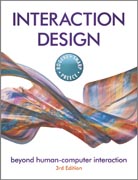
Interaction design: beyond human - computer interaction
Rogers, Yvonne
Preece, Jenny
Sharp, Helen
INDICE: Foreword Preface 1 WHAT IS INTERACTION DESIGN? 1.1 Introduction 1.2Good and poor design 1.3 What is interaction design? 1.4 The user experience 1.5 The process of interaction design 1.6 Interaction design and the user experience Interview with Gitta Salomon 2 UNDERSTANDING AND CONCEPTUALIZING INTERACTION 2.1 Introduction 2.2 Understanding the problem space 2.3 Conceptualizingthe design space 2.4 Theories, models, and frameworks Interview with Terry Winograd 3 UNDERSTANDING USERS 3.1 Introduction 3.2 What is cognition? 3.3 Cognitive frameworks 4 DESIGNING FOR COLLABORATION AND COMMUNICATION 4.1 Introduction 4.2 Social mechanisms in communication and collaboration 4.3 Technology-mediated social phenomena Interview with Abigail Sellen 5 AFFECTIVE ASPECTS 5.1 Introduction 5.2 What are affective aspects? 5.3 Expressive interfaces and positive emotions 5.4 Frustrating interfaces and negative emotions 5.5 Persuasive technologies 5.6 Anthropomorphism in interaction design 5.7 Interface agents, virtual pets, and interactive toys 5.8 Models of affective aspects 6 INTERFACES AND INTERACTIONS 6.1 Introduction 6.2 Paradigms 6.3 Interface types 6.4 Which interface? 7 DATA GATHERING 7.1 Introduction 7.2 Four key issues 7.3 Data recording 7.4 Interviews 7.5 Questionnaires 7.6 Observation 7.7 Choosing and combining techniques Interview with Sara Bly 8 DATA ANALYSIS, INTERPRETATION, ANDPRESENTATION 8.1 Introduction 8.2 Qualitative and quantitative 8.3 Simple quantitative analysis 8.4 Simple qualitative analysis tents ix 8.5 Tools to support data analysis 8.6 Using theoretical frameworks 8.7 Presenting the findings 9 THE PROCESS OF INTERACTION DESIGN 9.1 Introduction 9.2 What is involved in interaction design? 9.3 Some practical issues 9.4 Lifecycle models: showing howthe activities are related Interview with Gillian Crampton Smith 10 IDENTIFYING NEEDS AND ESTABLISHING REQUIREMENTS 10.1 Introduction 10.2 What, How, and Why? 10.3 What are requirements? 10.4 Data gathering for requirements 10.5 Dataanalysis, interpretation, and presentation 10.6 Task description 10.7 Task analysis Interview with Suzanne Robertson 11 DESIGN, PROTOTYPING, AND CONSTRUCTION 11.1 Introduction 11.2 Prototyping and construction 11.3 Conceptual design:moving from requirements to first design 11.4 Physical design: getting concrete 11.5 Using scenarios in design 11.6 Using prototypes in design 11.7 Tool support Interview with Karen Holtzblatt 12 INTRODUCING EVALUATION 12.1 Introduction 12.2 The why, what, where, and when of evaluation 12.3 Evaluation approaches and methods 12.4 Evaluation case studies 12.5 What did we learn from the case studies? 13 AN EVALUATION FRAMEWORK 13.1 Introduction 13.2 DECIDE: A framework to guide evaluation 14 USABILITY TESTING AND FIELD STUDIES 14.1 Introducti
- ISBN: 978-0-470-66576-3
- Editorial: John Wiley & Sons
- Encuadernacion: Rústica
- Páginas: 688
- Fecha Publicación: 25/03/2011
- Nº Volúmenes: 1
- Idioma: Inglés
